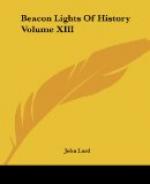In India, as chairman of the Board of Education, as legal adviser of the Council, and in drafting a code of penal laws for that part of the Empire, he was very useful,—although as a matter of fact the new code was too theoretically fine to be practical, and was never put in force. His personal good sense was equal to his industry and his talents, and he preserved his health by strict habits of temperance. Even in that tropical country he presented a strong contrast to the sallow, bilious officials with whom he was surrounded, and in due time returned to England in perfect health, one of the most robust of men, capable of indefinite work, which never seemed to weary him.
But in Calcutta, as in London, he employed his leisure hours in writing for the Edinburgh Review, and gave an immense impulse to its sale, for which he was amply rewarded. Brougham complained to Jeffrey that his essays took up too much space in the Review, but the politic editor knew what was for its interest and popularity. Macaulay’s long articles of sometimes over a hundred pages were received without a murmur; and every article he wrote added to his fame, since he always did his best. His essays in 1830 on Southey and Montgomery, and one in 1831 on Croker’s edition of Boswell’s Life of Johnson, were fierce, scathing onslaughts, even cruel and crushing,—revealing Macaulay’s tremendous powers of invective and remorseless criticism, but reflecting little credit on his disposition or his judgment. His Hampden (1831) and his Burleigh (1832) remain among his finest and most inspiring historical paintings. His first essay on Lord Chatham (1834) is a notable piece of characterization; the one on Sir James Mackintosh (1835) is a most acute and brilliant historical criticism; the one on Lord Bacon (1837) is striking and has become famous, but shows Macaulay’s deficiency in philosophic thought, besides being sophistical in spirit; and the article on Sir William Temple (1837)—really a history of England during the reign of William III.—is thoroughly fine.




